Honda has today announced the all-new CBR1000RR SP with a 14% improvement in power-to-weight ratio versus the outgoing model. Honda went big in replacing the long-in-the-tooth CBR.
In addition to the big power increase and weight reduction, the new bike gets a “cutting edge electronics package.” Honda is also homologating for superbike racing a limited edition CBR1000RR SP2 with larger valves and lighter forged Marchesini wheels (pictured). Take a look at the photos and video. Here is the full press release from Honda:
Model updates: The Honda CBR1000RR SP goes to the next stage of Total Control.
Power to weight ratio is improved by 14%—reaching the best level ever for the CBR1000RR—thanks to a 33 lb. weight reduction and 10 horsepower power boost.
It’s also equipped with semi-active Öhlins Electronic Control suspension, plus Honda Selectable Torque Control, Selectable Engine Brake, new ABS, Quickshifter, Downshift Assist, Riding Mode Select System and Power Selector. RC213V-S. MotoGP-derived technology elevates the riding experience even further.
Contents:
1 Introduction
2 Model overview
3 Key features
3.1 Chassis/electronics
3.2 Chassis
3.3 Engine/electronics
3.4 Engine
4 Technical specifications
1. Introduction
1992. And something new stunned the motorcycling world. Radical thinking from Honda focused on the ratio between power and weight and the CBR900RR arrived fully formed at the perfect balance point between the two.
Physically smaller and much more agile than the larger-capacity competition, its four cylinder engine also packed real punch. The CBR900RR reset expectations of just what an open-class sport bike should be, and what it could do in an era when outright horsepower and straight-line speed had long held center stage.
Over the following 25 years the CBR has seen many changes and been through many evolutions—each underpinned by the concept of Total Control. Each generation has built on the legacy of the original CBR900RR, providing a superbly balanced package that works incredibly well on track and, even more importantly, is both exhilarating and uniquely rewarding to ride out on the open road.
The fact the CBR1000RR is so good when actually raced on real roads—at the Isle of Man TT, for instance, where it is the most successful 1000cc machine ever, with 23 wins to its name—is testament to its speed, handling and ability to perform in the most testing and extreme of “real world” conditions.
2017, and the 25th anniversary of the CBR900RR sees the introduction of a new CBR1000RR SP. Honda’s engineers have remained true to the first principles of the original project—power to weight—with the focus on cornering, acceleration and braking. Thus the 2017 CBR1000RR SP is significantly lighter than the outgoing model, makes more power and is fully loaded with a cutting-edge electronics package that underpins the project’s development concept of Next Stage Total Control.
It is everything that a CBR1000RR SP should be, and more.
Mr. M. Sato, Large Project Leader (LPL) 2017 CBR1000RR SP
“All 1000cc sport bikes are extraordinary examples of high-performance engineering. But for us, for our new CBR1000RR SP we want extraordinary to be the pleasure of handling and controlling such a machine. Its true purpose—wherever it’s ridden—is to enjoy something that is not normally experienced in everyday life, something that cannot be surpassed.
The very first CBR900RR remains a milestone in our history, and an inspiration we have drawn on to radically reduce weight and increase power. And, to go to Next Stage Total Control, we have added an electronic control system that is there to support the rider, totally.
What then can our new CBR1000RR SP promise our customers? That is simple—the pure joy of riding.”
CBR1000RR SP – Next Stage Total Control
2. Model Overview
Three factors are key to the essence of the new CBR1000RR SP; less weight, more power and electronics to help the rider wherever and however they’re riding.
The new electronic control system provides constant, selectable and fine-tunable rider support. Central to the system is the 5-axis Inertial Measurement Unit (IMU), which measures exactly what the machine is doing, in every plane. It works the Honda Selectable Torque Control (HSTC) that precisely manages rear wheel traction via the FI-ECU and Throttle By Wire (TBW). The new ABS (also managed by the IMU) offers Rear Lift Control (RLC) and the ability for hard, safe trail braking into corners. Any difference measured between the front and rear wheel speeds engages Wheelie Control, depending on settings.
It also works with the Öhlins Objective Based Tuning Interface to adjust both the compression and rebound damping force of the semi-active Öhlins Electronic Control (S-EC) front fork and rear shock. For the rider this means access to a whole new level of handling ability, with suspension reaction—whether working through pre-sets 2017 CBR1000RR SP or manual input—that delivers exactly the right amount of control in every situation. It functions as well on the road as it does the track, and for Honda a new era begins.
At the same time as the S-EC is working the suspension, the Honda Selectable Torque Control (HSTC) is precisely managing rear wheel traction through the IMU, FI-ECU and Throttle By Wire (TBW). It also delivers a Wheelie Control function. Three standard display modes—Street, Circuit and Mechanic—provide all the information required for the rider relevant to the type of riding. The information displayed can be fine-tuned and adjusted while riding by using the left-hand switch gear and TFT liquid crystal display, just as on the RC213V-S, Honda’s road going version of its RC213V MotoGP machine.
While the electronic control is very much a new departure for the CBR1000RR SP, the combination of the other two factors draws faithfully on the philosophy of the original 1992 machine: the optimal balance of power and weight. The engine revs harder and higher, with a much higher compression ratio and revised cam timing, and uses the TBW (a first for an inline four-cylinder Honda) and Acceleration Position Sensor (APS) which have been inspired by the technology developed for the RC213V-S.
Bottom-end torque and power are improved, with a significant increase in top-end power—up 10 hp—and 3 modes of engine output character can be chosen from. A Quickshifter is fitted as standard, as is Downshift Assist (with auto-blipper) and new assist slipper clutch.
Thanks to the use of magnesium and careful assessment and lightening of individual parts, the engine also carries 4.4 lbs. less. The new titanium exhaust muffler saves further weight and aids mass centralization, as does the titanium petrol tank. Overall the CBR1000RR SP is 33 lbs. lighter than the outgoing model.
The twin-spar aluminum frame’s rigidity balance has been finely adjusted, and the swingarm is stiffer to match. A new rear subframe is lighter as are the redesigned wheels, while Brembo monobloc four-piston front brake calipers use high performance track-ready brake pads.
The CBR1000RR SP ’s bodywork outlines an aggressive, functional minimalism, and the machine is slimmer and much more compact with a single seat unit fitted as standard. All lighting is LED and the stunning Tri-Color paintwork—on a red base—harks back to Honda racing history.
3. Key Features
3.1 Chassis/Electronics
• Inertial Measurement Unit (IMU)
• Öhlins Electronic Control (S-EC) suspension
• Honda Selectable Torque Control (HSTC)
• New ABS
• Riding Mode Select System (RMSS)
The CBR1000RR SP is the first Honda motorcycle to be equipped with Öhlins S-EC suspension front and rear: a 43mm NIX 30 fork and TTX 36 shock.
The Suspension Control Unit (SCU) receives roll rate, yaw rate and lean angle information from a 40g 5-axis (3-axis acceleration and 2-axis angular velocity) Bosch MM5.10 IMU gyro located close to the machine’s center of gravity. It also gathers wheel speed, engine rpm, brake input and throttle angle from the FI-ECU and, depending on the suspension mode selected by the rider delivers optimal compression and damping force (adjusted via each step motor) during normal riding, plus hard acceleration, braking and cornering.
There are three Active modes and three Manual modes for the rider to choose from. When set in Active, damping force is controlled and optimized to suit the riding conditions: A1 (“Fast”), A2 (“Enjoy”) and A3 (“Safety”). Within the Active Modes the rider can make finer adjustments. The Manual M1, M2 and M3 Modes allow any required adjustments to be made.
Within the electronic control system are a multitude of active features that many riders will find useful. The new ABS allows extremely hard braking while maintaining rear wheel contact with the ground, stopping the tendency for the rear of the machine to elevate or “back in” around the front. It uses the 2-axis acceleration information from the IMU and calculates the acceleration of the machine’s center of gravity in the lift direction and acceleration perpendicular to that, using the front wheel as a grounding point.
ABS delivers smooth, effective braking into a corner. With information from the IMU, plus front and rear wheel speed sensors, the ABS Modulator controls braking force according to lean angle, even when panic braking. But it also allows for hard trail braking by using two parameters (deceleration derived from wheel speed and front/rear slip rates) plus lean angle to vary the threshold for ABS decompression. ABS delivers an extra sense of security when braking hard on the road, and offers a performance edge in certain conditions on the racetrack.
In isolation all the functions of the EBC—plus the HSTC’s wheelie control—perform specific, individual tasks. When tied together, however and working seamlessly as one they provide technological rider support that elevates the super sports experience, without turning the rider into the passenger. Next Stage Total Control, indeed.
Like the RC213V-S, the CBR1000RR SP uses a full-color TFT liquid crystal dash that clearly communicates information to the rider. It automatically adjusts to ambient light, with a backlight of up to 1000 cd/m2 luminescence and features 3 modes; Street, Circuit and Mechanic, each displaying information most relevant for usage.
Street displays riding modes (1-3 and USER 1-2) plus the settings for each parameter P (Power), T (HSTC), EB (Selectable Engine Brake) and S (Suspension). Circuit adds in addition to Street mode the lap time, number of laps and difference from the best lap. Mechanic displays the digital tachometer, gear position, grip angle, coolant temperature and battery voltage.
Riding mode 1 (FAST) gives full power, with linear throttle response, low HSTC and EB intervention and high damping force. Mode 2 (FUN) controls output through first to third gear, with fairly moderate power increase, medium HSTC, strong EB and medium damping force. Mode 3 (SAFE) controls output through first to fourth gear, with moderate power increase, high HSTC, strong EB and low damping force.
In the 2 USER modes all parameters can be combined and adjusted freely; riding modes, HSTC and suspension settings can be changed while riding from the up/down switch on the left switchgear.
The Shift-Up indicator is a horizontal line of 5 white LEDs located at the top; when engine speeds exceed user presets they go from solid to flashing. Displays include speedometer, tachometer, gear position, quickshifter, coolant temperature, riding distance and twin trip meters.
The onboard computer calculates instantaneous and average fuel economy, trip fuel consumption, average speed and time after last ignition plus remaining fuel after RES light and distance to empty (when selected). This information is shown on the bottom right of the screen. In the upper display, middle right the rider can choose to see the Shift-Up indicator setting speed, grip angle, battery voltage, calendar, or user-defined text.
Switching between modes is controlled by a mode switch on the right of the left-hand switchgear. Just above it is an up/down switch that manages and changes the information displayed within the mode.
3.2 Chassis
• Adjusted rigidity balance for the frame
• Stiffer swingarm
• Lighter subframe
• Titanium fuel tank
• Brembo four-piston radial mount monobloc brake calipers
• Redesigned wheels
• Minimal and aggressively styled bodywork
As a machine now a full 33 lbs. lighter and with a 10 horsepower power boost, the CBR1000RR SP’s physical handling has also been transformed. Rake and trail remain 23° 3’/96mm but the hollow die-cast twin-spar aluminum frame’s rigidity balance has been significantly adjusted to give even sweeter handling with outstanding steering response, feel and stability.
Thinned frame walls save 300 grams. While transverse rigidity is unchanged, the frame is 10% more flexible in the torsional plane, which works to deliver a fasterreacting chassis. Yaw moment of inertia has been reduced by 15%; roll moment of inertia by 10%. The Honda Electronic Steering Damper (HESD) unobtrusively maintains stability. To complement the frame changes the aluminum Unit Pro-Link® swingarm’s hybrid structure has had the thickness of each section adjusted, saving approximately 100 grams while maintaining transverse rigidity and increasing torsional rigidity.
The die-cast aluminum subframe too has been redesigned and its thinner construction is at the same time highly rigid and 800 grams lighter—contributing to the concentration of mass and thus neutral handling feel with improved agility. Wheelbase is 55.3 in.; seat height is 32.3 in.
Positioned high, the weight of the fuel tank (and fuel) plays a significant part in a motorcycle’s handling. In another first for mass production, Honda has developed a compact 4.23 gal. titanium fuel tank for the CBR1000RR SP. Manufactured by an ultra-deep drawing process, it’s 2.86 lbs. lighter than an equivalent steel design and contributes to the concentration of mass and reduction in the moment of inertia.
Brembo four-piston monobloc radial mount brake calipers use newly developed highmu (coefficient of friction) brake pads—these have a greater performance parameter at higher temperatures than standard pads, and suit aggressive riding. The aluminum wheels are a new five Y-shape spoke design, saving approximately 100 grams. Tire sizes are 120/70 R17 front and 190/50 R17 rear.
Minimal and dynamic are two words used to best describe the CBR1000RR SP ’s new styling. The design team wanted to create tightly compact proportions and the upper and middle fairing surfaces have been reduced in size as far as possible. Forward tilting character lines inject an aggressive attitude, with a focus on mechanical functionality, detail and quality of finish.
24mm in width has been squeezed from the upper fairing. Airflow control from the flow surfaces of the fairing, to the surface angle of the headlights and the contouring of their side slits supports stability at speed. In a racing crouch the rider is tucked well out of the airstream. In normal riding situations air pressure is evenly distributed on the rider’s shoulders, back and sides.
18mm has been saved across the middle fairing and its “knuckles” double as RAD intake structures that pass discharged air around the outside, and underneath, the rider’s legs. The knee grip area is 15mm per side slimmer, with the interface between tank cover and the single seat unit athletically accentuated.
All lighting is crisp LED, with the twin front headlights offering high/low beam on both sides. Crowned with a sharply angled new logo, the CBR1000RR SP will be available in a Tri-Color paint option that uses red as its base (rather than white) and pays homage to Honda’s racing tradition and history. Wing-motif patterns underpin the machine’s exclusivity.
A 2.2 lb. Lithium-Ion battery saves weight (a lead-acid unit of similar output would weigh 4.4 lbs.) and provides reliable and consistent electrical charge.
3.3 Engine/Electronics
• Throttle By Wire (TBW)
• Acceleration Position Sensor (APS)
• Power Selector
• Inertial Measurement Unit (IMU)
• 9 level Honda Selectable Torque Control (HSTC)
• Wheelie Control
• Selectable Engine Brake (SEB)
• Quickshifter
• Downshift Assist
• Riding Mode Select System (RMSS)
The 2017 CBR1000RR SP is the first inline four-cylinder engine from Honda to use Throttle by Wire (TBW) control. Derived and developed from the system used by the RC213V-S, its job is to put precise throttle control—and a very natural feel—in the rider’s right hand.
Heart of the system is a newly developed throttle grip Acceleration Position Sensor (APS) integrated into the right handlebar switchgear, which itself neatly mounts the engine start/stop switch—nothing more. APS converts movement of the grip into an electrical signal sent to the ECU, that then transmits it as an actuator signal to the TBW motor, achieving ideal throttle control relative to grip angle.
The return spring and other mechanisms inside the APS reproduce the initial play and natural feel of a cable, with throttle load set specifically for the CBR1000RR SP. Working in conjunction with the APS, throttle bore is increased 2mm to 48mm (without increasing exterior width) and careful shaping of the intake funnels adds to the linear throttle response.
The Power Selector can be accessed through the Riding Mode Select System (RMSS). It offers 5 levels of output character: Level 1 give peak output in all six gears; Level 2 output is controlled in each gear to achieve smooth throttle feel under acceleration or deceleration; Level 5 has the strongest output control for most moderate throttle response. All levels have the same throttle response on initial opening.
Riding Mode (1) uses Level 1 as its preset, drawing out the full performance of the engine. Mode (2) uses Level 2, and is suitable for twisty roads, while Mode (3) goes to Level 5 for maximum security. Individual rider preferences can also be input manually through the USER 1 and 2 interface.
The CBR1000RR SP employs an enhanced version of the Honda Selectable Torque Control (HSTC) used on the RC213V-S. It controls engine torque via two sensing methods—the first uses wheel-speed sensors to measure and compare front and rear wheel speeds. When the FI-ECU detects rear wheel acceleration (and front wheel deceleration) it reduces the TBW throttle position, and thus output, keeping the front wheel on the ground. Maximum application of the throttle is thus possible without fear of wheelies, with the support of Wheelie Control.
The second sensing function detects machine roll angle. The IMU located under the seat detects rotational speed in the chassis’ roll and yaw directions, and acceleration in the longitudinal, lateral and vertical directions. It then calculates roll angle to 2017 control engine torque, maintaining rear wheel traction at the required level. The body roll calculation logic used by the ECU uses the same attitude detection technologies developed for Honda’s ASIMO humanoid robot, enabling the most precise calculation possible.
Nine intervention levels (plus off) are offered by HSTC to suit rider preferences, and
the Riding Modes USER 1 and 2 enable individual changes to be made while
moving.
There is also a Selectable Engine Brake (SEB) system to change engine-braking character to match rider preference and a range of conditions. Level 1 offers the highest braking force, Level 3 the lowest. The preset Modes 1, 2 and 3 use recommended settings, but through USER 1 and 2 can be set individually.
A Quickshifter is fitted as standard for clutchless upshifts and works through fuel injection cut and ignition retard. It has 3 settings plus off. Downshift Assist allows clutchless downshifts, and also works via fuel injection cut and ignition retard with TBW autoblipping. It too has 3 settings plus off.
3.4 Engine
• 10 hp increase
• Revised valve lift and cam timing
• Magnesium covers and detail redesign saves 4.4 lbs.
• 4-2-1 exhaust with titanium muffler
• Redesigned downshift assist
• New assist slipper clutch
Honda’s engineers exhaustively re-examined the CBR1000RR SP’s 999.8cc inline four-cylinder engine to make it as light and powerful as possible. The result of the work is an extra 10 hp, the loss of 4.4 lbs. and raised rev ceiling of 13,000 rpm.
Bore and stroke remain 76 x 55.1mm but compression ratio is up from 12.3:1 to 13:1. This is an engine in a very high state of tune and the crankshaft, valve train and transmission all use higher specification materials than the previous design.
The pistons feature an optimized wall thickness and a new crown design to raise the compression; the surface finishing of the piston-ring grooves has also been modified to improve sealing performance and efficiency. Valve lift and cam timing has been revised to match the higher rpm and greater engine performance.
Power up is just one part of the CBR1000RR SP ’s story—reduced weight is another. So every part of the engine was scrutinized to see if it could be made lighter. All the engine covers are redesigned (clutch cover is aluminum; the ignition cover magnesium) and the length of the bolts, water hose and water hose bands have been reduced.
With a revised, rounded shape the radiator is 30mm narrower in overall width and 100g lighter (including a 30cc reduction in water capacity). Using a new high-density core it achieves identical heat dissipation and contributes to the slimmer frontal area of the fairing cowls.
The assist slipper clutch is completely revised with a single die-cast pressure plate and clutch center, and offers reduced load at the lever. For downshifts the slipper functionality remains the same as before but aluminum cam parts (instead of steel) save weight. The gap between the accelerating and decelerating cams has also been optimized, again improving lever feel when changing gear. All of the transmission gears have been pared down to save weight.
The titanium irregular cross-section muffler is 6.17 lbs. lighter and minimizes the center of gravity change; it also creates an unmistakable sound tone from the exhaust on an open throttle. The exhaust supplier to the Repsol Honda MotoGP team was asked to develop the prototype and produced an exquisite design with the 4-2-1 double-skinned downpipes incorporating the exhaust valve within the first main pipe.
See more of MD’s great photography:
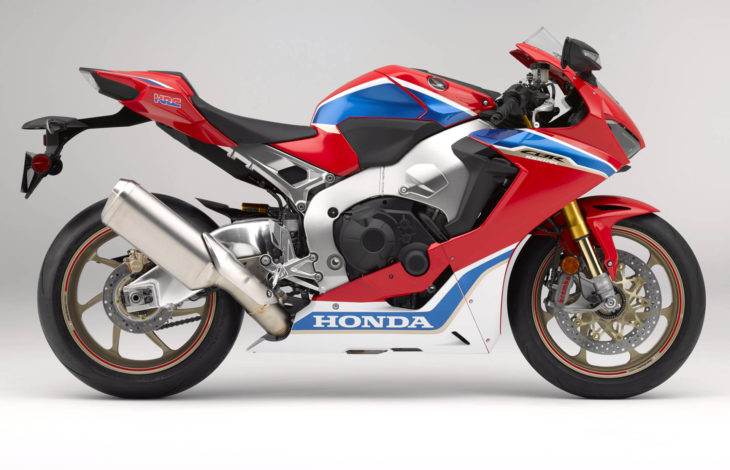

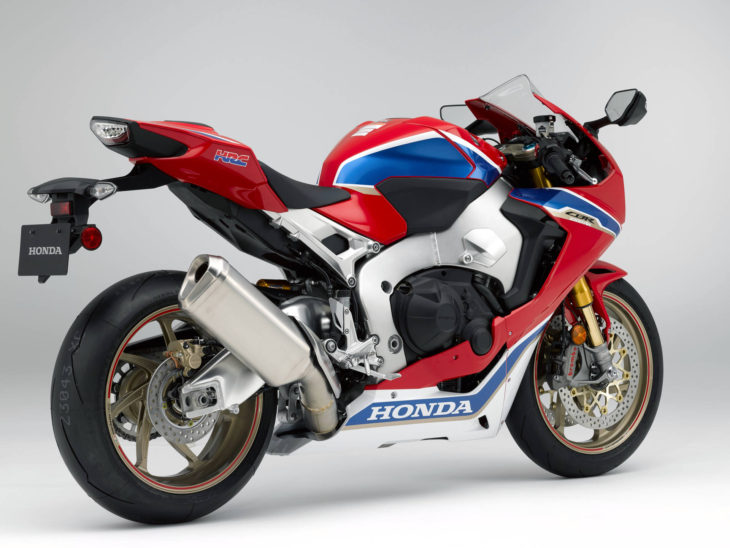
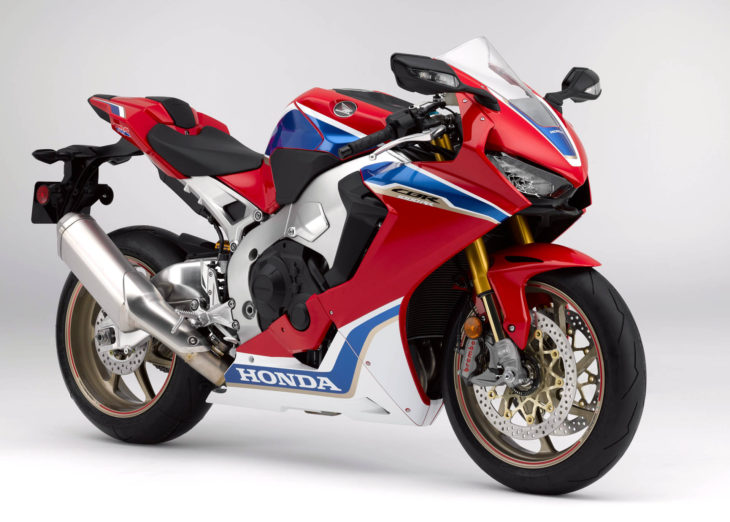

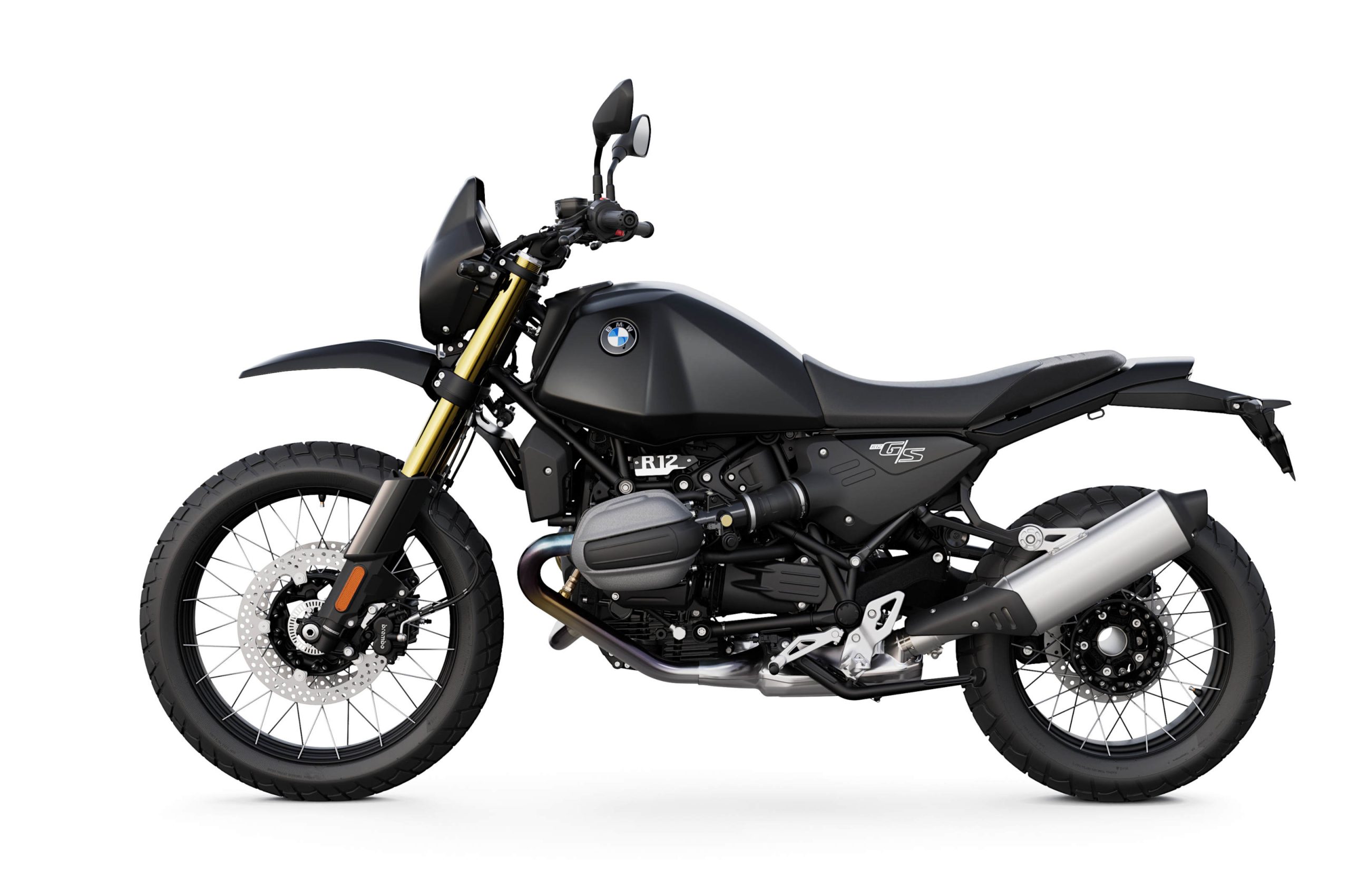
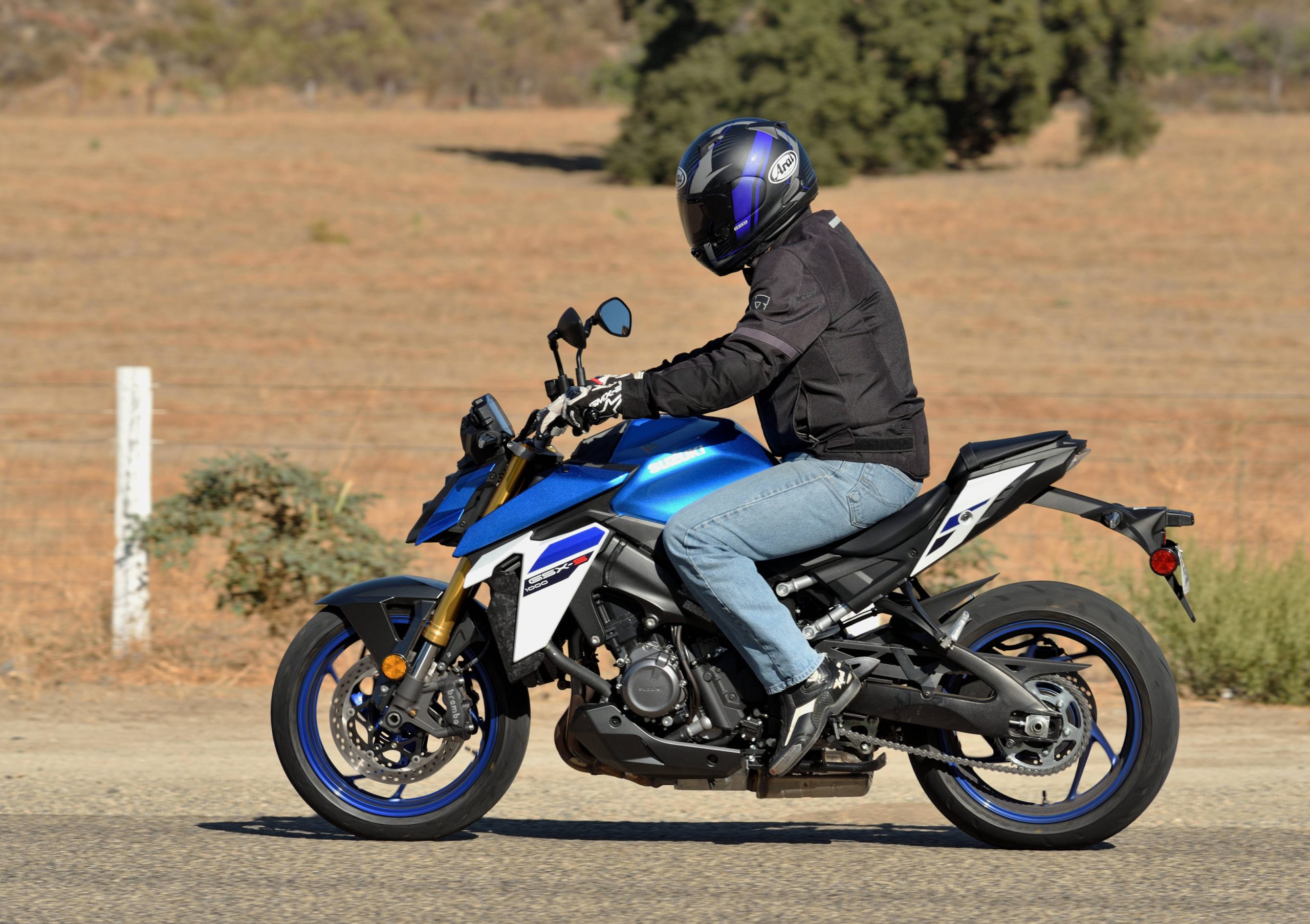
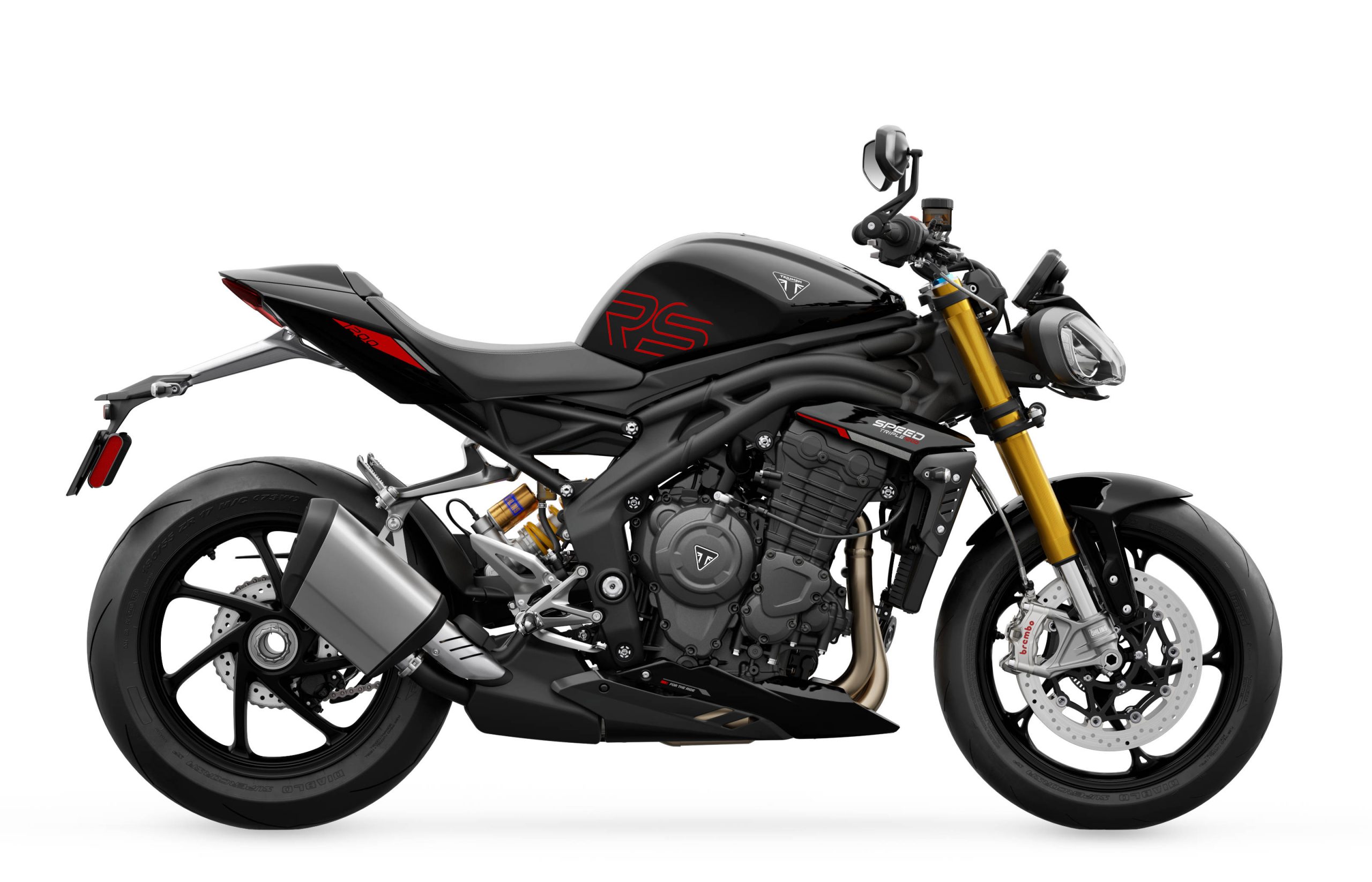
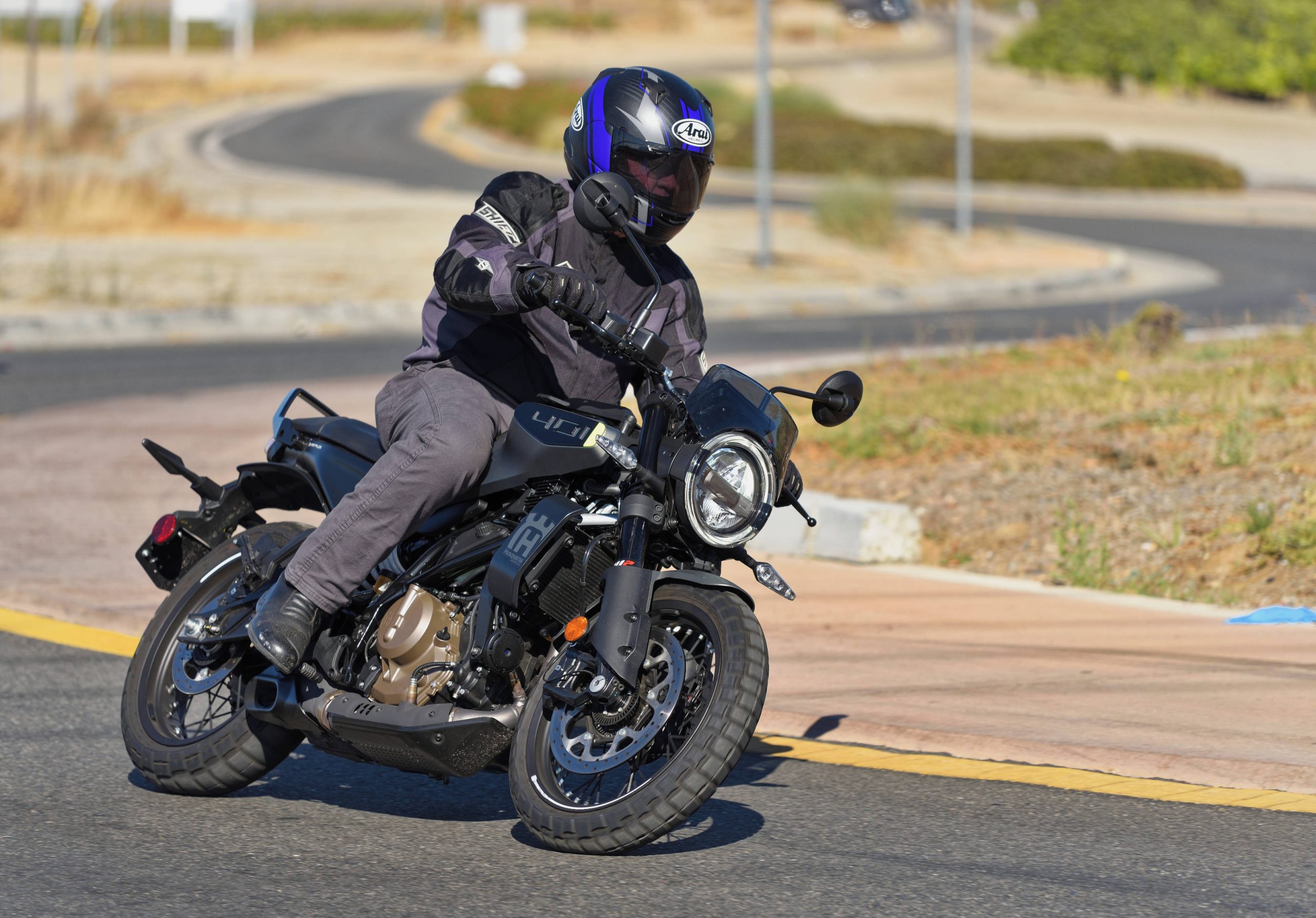
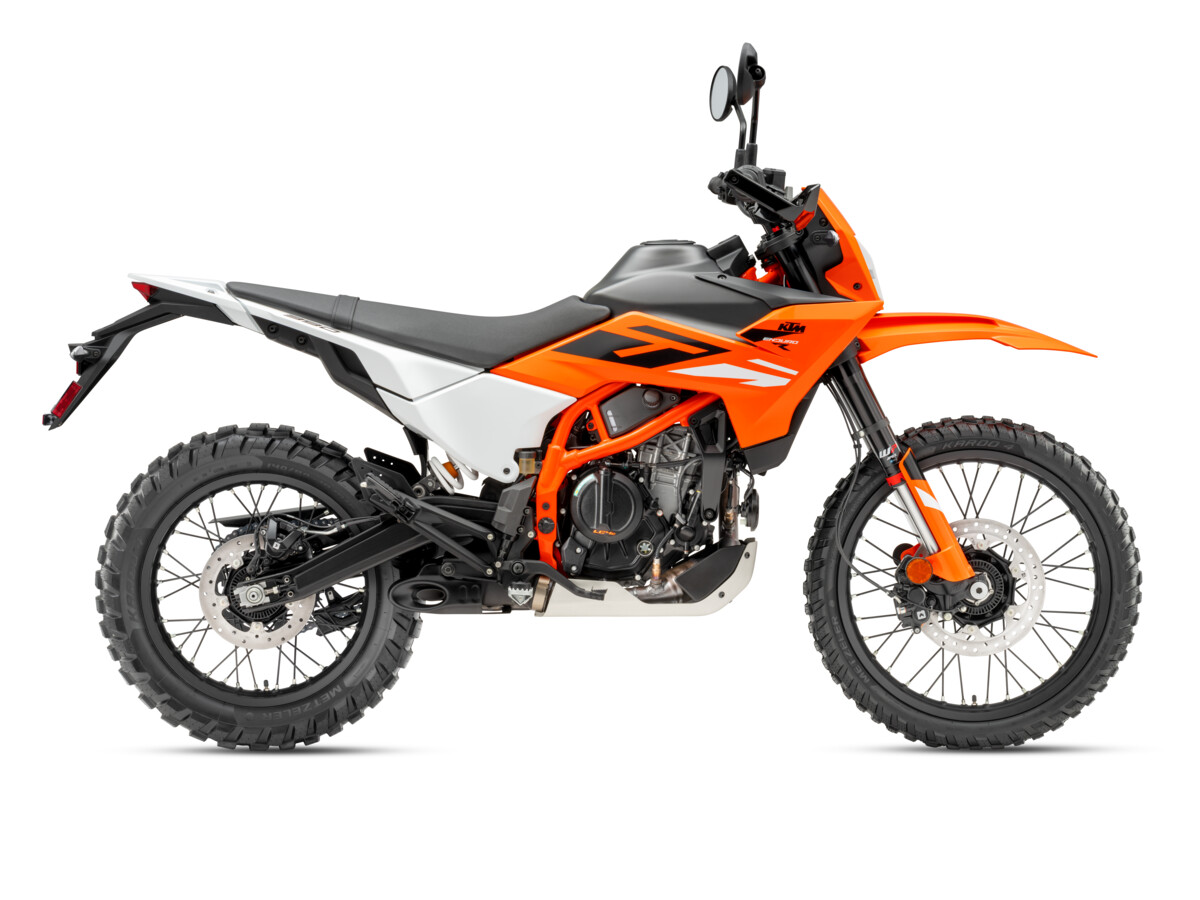
Love the bike, great design, I’d like to see a curved sub frame just deep enough to round out the symmetry and hide the black plastic tub under the seat. I love the slanted front and headlights. I can’t wait for the tests of all the new superbikes.
33 lbs lighter….. About 410-415 lbs ready to ride then?
Yeah…..17,000 to 25,000 is the new median price range for Liter Bikes…..I’m out. Looks like cars and motorcycles will always be a 2nd hand purchase from now on. Darned inflation anyways…my income increases at a much slower pace. Truly stunning bike from Honda though….it definitely has an exotic flare about it that Honda has been lacking since the 929 in my opinion.
Nice, simple, modest muffler. Why are some so large and ungainly? (I’m look’n at you, Kawasaki.)
Too uncomfortable for the street but this genre has been that way for years. I will pass but I can see why some people would want one!
It’s about time Honda. My 08 has 34k on the clock but I just installed Ohlins front & back about a month ago so I probably won’t be in the market in 2017. Maybe 18 or 19.
re: “It’s about time Honda”
the sleeping giant is now fully awake. the Africa Twin, the hybrid/twin turbo NSX, RC213VS, a turbo Civic engine hatchback now available with a manual box, Kawi green paint (with still the classic Si and type R models to come). and now we have the everyman’s Blade finally gaining it’s suite of electrics.
not only are the lights on…? but i reckon the homeowner’s still out in the shed going “hammer and tongs”. though it remains to be seen if Yanks are going to be allowed access to the HRC kit…? if you recall, there was much “C-blockage” regarding the 213…
https://youtu.be/umDtXl3ysMM?t=4m30s
Now that’s one satisfied RC213VS owner!
Based on cosmetics only, between this Honda as the Yamaha SB, which one do you guys prefer? First blush I thought I still preferred the Yamaha, Honda a closed second. Second glance I might reverse that order. If possible, finish quality on the Honda might even exceed that of the Yamaha (based on images only). When Honda puts their nose to the grindstone there’s few if any better finish qualities.
Hoping Nicky takes no prisoners on this beauty! Would love to see a Honda 1/2 finish in WSBK.
Tough call. I really like the Yamaha and its MotoGP-ish look, and like you I thought I liked it better initially. Yet the more I look at the Honda, the more I like it. I’d have to see them side by side I think to make the call. They are both beautiful bikes in my opinion.
The Honda’s fairing wins it for me. I like bikes that look like race bikes, and part of that is the full fairing, especially along the bottom. I put a Yoshi exhaust on my ’08, partly because it came with a fairing extender. I also added a slightly taller GP style windscreen (yes, it’s clear); I might do the same if this bike were in my budget. I wonder how this bike will do against the R1 and ZX-10 in the next shoot out?
re: “irregular cross-section muffler is 6.17 lbs. lighter and minimizes the center of gravity change; it also creates an unmistakable sound tone from the exhaust on an open throttle. The exhaust supplier to the Repsol Honda MotoGP team was asked to develop the prototype and produced an exquisite design”
mission accomplished. i’m watching/listening to the video wondering is it live…? or is it Memorex…? pretty damn “orchestral” for a stock canister.
re: “titanium fuel tank”
re: “titanium exhaust muffler”
okay, but these are NOT the Droids Nicky’s looking for. rods would be nice, but Ti6Al4V better be in valve train of the SP2 at a minimum or you’re going to hear about it. from me mostly, but you’re going to hear about it.
re: “190/50 R17 rear”
what is this 1999…? that 50 section is a typo, yes…?
Moto Gp inspired exhaust….Honda speak for we need to add a huge can for Euro 4
wonder what Nicky will think of the block off plates on the frame spars indicating this is the 08-16 model will added electronic wizardry
might just work ?
55 series rear works wonders as a update to the previous models
8 yrs have trickled by but its still a revision on the previous one…….your take Norm ?
re: “wonder what Nicky will think of the block off plates on the frame spars indicating this is the 08-16 model will added electronic wizardry”
Nicky flashes his trademark Chester Cheetos grin.
re: “your take Norm ?”
revisions are perfectly acceptable. honestly the bike didn’t need wholesale changes in order to be competitive (well other than a top end “home makeover”). dimensionally the Blade’s bore and stroke have always been a near carbon copy of the Zed, or is that the other way ’round…? anyway, as we see in 2016 (much of this is due to Ten Kate boffins mind you) the kit is still there or thereabouts even WITHOUT J-Rea on it.
dare I say they may have tweaked the 2017 chassis a little too much…? time will tell, but the changes do sound eerily similar to what i recall happened 15 years ago when the overly stiff SP1 chassis updated to SP2 spec, which then made it much more competitive. the sum total of these changes of course launched Nicky to an AMA title that year, and gave us CEII v. Bayliss and the now legendary 2002 Imola showdown.
Have there been any indications what all this marvelous technology will COST the middle class income rider??
Any prices set / discussed-even if it’s in Euros to get a feel for how deep one will have to dig into the ol’ wallet?
Q: Have there been any indications what all this marvelous technology will COST the middle class income rider??
A: survey says…!!! (*ding*) “all the money”. ’twas the #1 answer… (ex-pat Richard Dawson voice)
https://www.youtube.com/watch?v=pKotjMAOC8U
Norm G
Thank you for the U-Tube link.
Well at close to $20K that takes ME out of the market.
Maybe a used one in a few years time. :(.
:(.
Gorgeous bike. Love that they ditched the one-eye headlight nonsense and gave it two lowbeams and two highbeams. Beautiful dash, too. Great paint scheme.
If I was going Japanese racebike this year, this would surely be the one. Not sure I’d take it over the new Aprilia V4, but I’d take this one over it’s Japan, Inc. brethren.
I think it is a great-looking bike. Honda did a good job with it. A 33-lb weight reduction is a pretty dramatic accomplishment for a bike that was already pretty light to begin with. Love the color scheme.
With all the rider aids this has to be the safest sports bike ever built. I think we all need to learn how to ride without all the “extras” in order to be able to understand the vehicle dynamics how to react to them. However for experienced group, this bike can be used to more comfortably test the limits of their abilities. Really impressive.
What a gorgeous bike! Do you think the USA will get the beautiful colors or will we get stuck with matte gray and matte black?
This is the best looking CBR/ Fireblade since the ’92 and ’94 restyle. The upper fairing is unique. The Tri-color HRC livery is just sexy as hell. Finally a bike worthy of the HRC logo (sorry CBR 300).
Honda has really done their homework here and with Nicky riding it hopefully they will be back to their WSBK winning ways.
And good for Honda for not trying a “one size fits all” and offering different levels of spec.
As nice as this revised CBR is…I think many are still asking where is this V4 RC30/45 successor that Honda has (themselves!) kept teasing us about for years. Most cannot afford a road going RCV, but the masses seem to want an Aprilia RSV4 level sport/ streetbike.
Go Nicky!
I really could care less about the electronic package for the street
It uses the same model from 08 as a basis for this current edition…which says alot for the previous one Glad I still have my 08 CBR in my fleet… I see the same frame…same swingarm and engine cases The holes in the frame for the air induction are blanked off as an afterthought ??
the 33 lb reduction is on the Race SP I suspect the savings is less impressive on the base model As it was already close to the lightest bike in its class including the Aprilia
assumed the blanks are sacrificial frame sliders?
I’m thinking the air is coming in further up…..but the snorkels that fed those blanked off holes are gone with these new plastics and bold new graphics…..
The previous bike is/was so well balanced and had the most meaty midrange with low weight….I’m not surprised it forms the basis for the 2017 model
Update for Euro4 and add electronic throttle with the wizardry of stability control Add some upper end power will it be enough ???
The frame and swingarm are different:”Honda says its adjusted the frame’s rigidity balance, so it’s now 10% more flexible in the torsional plane – a change designed to make the chassis feel more reactive. It’s also got thinner walls to save a claimed 500g. Honda also says the aluminium subframe is also 800g lighter.
The swingarm is claimed to be stiffer and lighter thanks to adjustments made to its thickness at various points.
At 1,404mm, the 2017 Fireblade’s wheelbase has been shortened by 6mm the seat height has increased by 11mm to 831mm.”
I want one, too bad my 2004 Interceptor is plenty fast, dead on reliable and COMFORTABLE.
Le sigh I’m old…
That exhaust tube looks huge.
33 pounds is a lot….
Open shootout it’s going to be nice
Many of the new exhaust cans are huge. Euro4 must be tough…
I like it! Now maybe Nickys got a winning tool. I’m not a big fan of electronics, but for some strange reason I’d trust Honda with ’em. They’re all outta my league though, skill and finance wise. By the time I get to live closer to a track, I’ll be lucky to be able to ride a bicycle.
It’s nice to see a sportbike designed with the goal of favorable “power to weight – with a focus on cornering, acceleration, and braking”. Good plan. Why didn’t anyone else think of that?
Anyway… Cool video. Nice bike. Now go win, Nicky.
I get that the muffler is lighter and meets emission regulations, but aesthetically, it’s probably the only backwards step from the previous Fireblade. Another site had photos of this and the outgoing model parked side by side, and it really does look more modern from every angle sans exhaust. As far as motorsport aspirations go, I reckon it’ll be great as a road racer, possibly winning Senior TTs again after a year of bedding in. Short circuit racing, I’m not so sure.
Blame euro regulation , noto the design team. There’s a sketch of the new model on another site, nice, short and similar to the previous model. Guess the engineering team couldn’t pass regulations with that and was forced to design that big can.